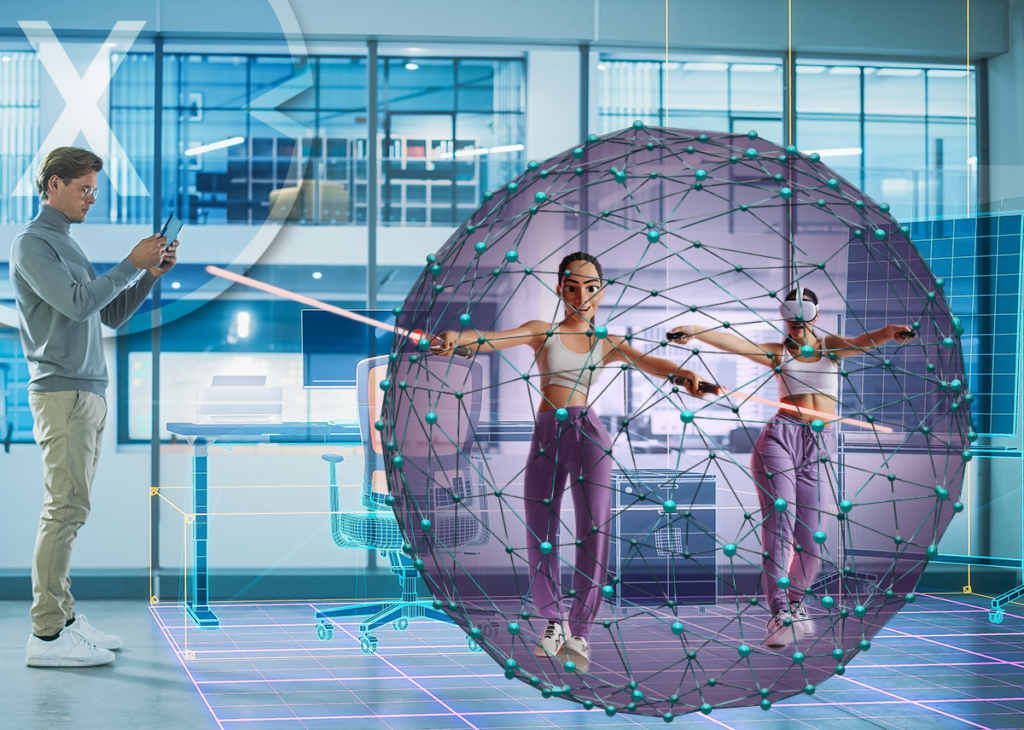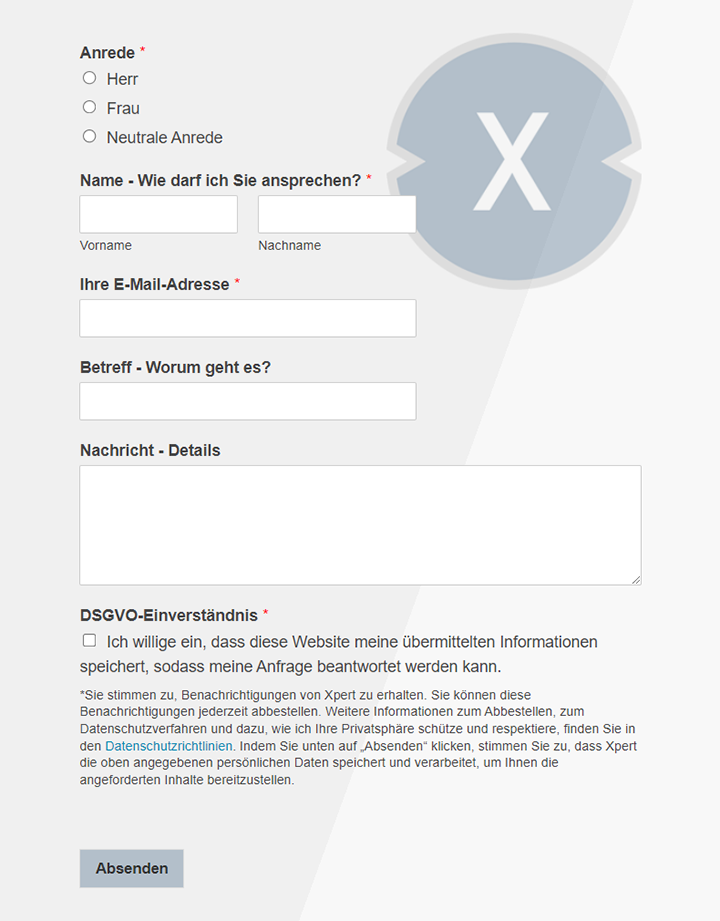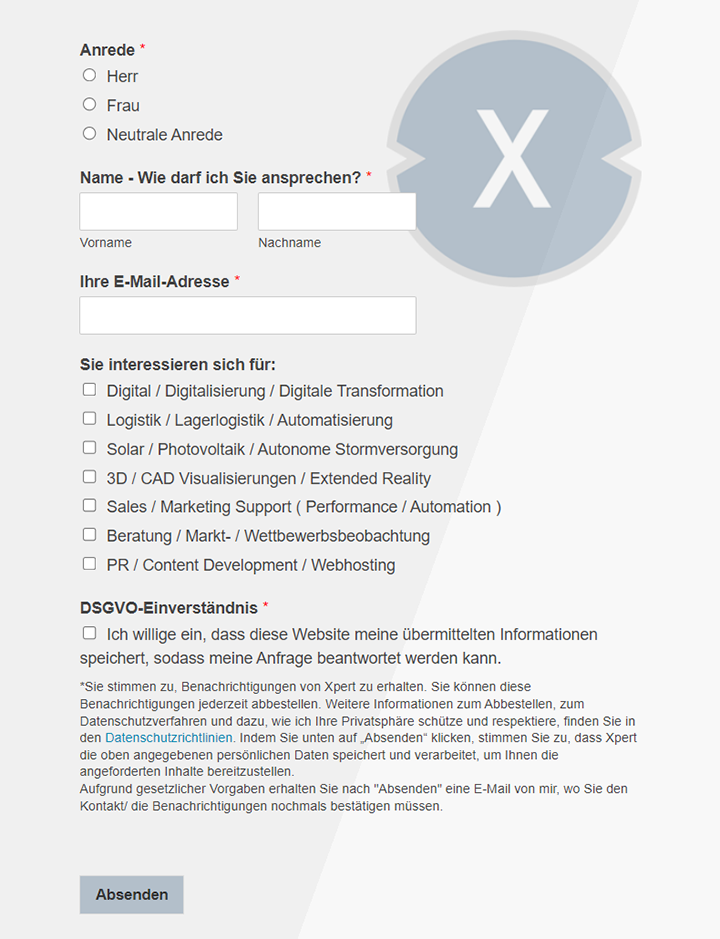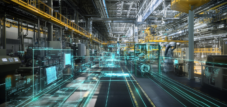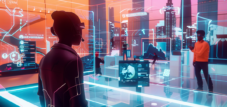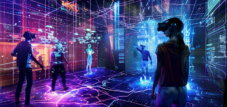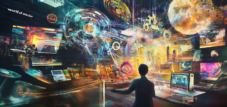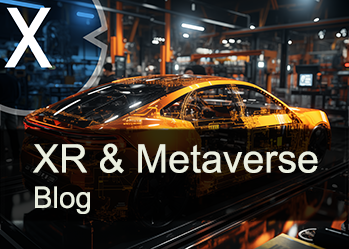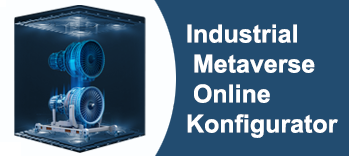Real digital cooperation is collaborative, immersive and transformative
Xpert pre-release
Language selection 📢
Published on: February 18, 2025 / update from: February 18, 2025 - Author: Konrad Wolfenstein
Innovation Live: The industrial metaverse as the driver of the real economy - at a glance!
Immersive engineering and collaborative cooperation in industrial metaverse: a transformative symbiosis
The combination of immersive engineering, collaborative work methods and meta-verse technologies revolutionizes industrial product development and production. While the general meta -verse is still looking for commercial load -bearing capacity, industrial metaverse plays a pioneering role as an innovation driver in the real economy. This report illuminates the technological, organizational and economic effects of this development based on current research projects and industrial initiatives.
Suitable for:
- For hybrid teams: Success factors of collaborative platforms
- What advantages do collaborative platforms offer compared to traditional work models?
Technological foundations of Immersive Engineering in industrial meta -verse
Networked XR environments as a basis
Modern Extended Reality (XR) technologies such as Virtual Reality (VR), Augmented Reality (AR) and Mixed Reality (MR) form the technological basis for immersive engineering processes. New developments such as the instance initiative of the Fraunhofer IAO replace traditional VR glasses with high-resolution projection systems, real-time graphics architectures and precise tracking systems. These systems enable teams to interact with identical virtual prototypes at various locations.
A significant innovation is cave technology (Cave automatic virtual environment), in which powerful 4K projections are combined with 360 ° tracking. At the center for virtual engineering, this technology significantly improves immersion compared to conventional head-mounted displays and enables seamless integration into existing development environments.
Integration of CAD/PLM systems with XR interfaces
A crucial success factor is the linking of author systems such as CAD (computer-aided design) and CAE (computer-aided engineering) with the virtual environments. Systems such as Siemens' NX Immersive Designer demonstrate how parametric 3D models are seamlessly transmitted into mixed reality glasses. Design changes can be saved back to Product Lifecycle Management (PLM) system in real time, which eliminates media breaks and developing development processes.
Progress in physically accurate simulations
Thanks to advanced ray tracing engine and physics simulations, material properties, flow behavior and mechanical stress can be realistically displayed. NVIDIA OMNIVERSE enables GPU accelerated multiphysics simulations that offer up to 40 % faster iteration cycles. Systems such as Holo-Lights AR3S allow finite element analyzes in augmented reality, so that calculation results can be visualized directly on physical prototypes.
Collaborative work models in industrial metaverse
Multimodal interaction methods
Modern XR systems combine voice control, gesture recognition and haptic feedback for intuitive operation. The integration of 6dof controllers (6 degrees of freedom) in Siemens' partnership with Sony improves precision when manipulating virtual assemblies. Eye-tracking systems analyze the attention distribution in design teams, which reduces up to 60 % compared to traditional VR interfaces.
AVATARE for asynchronous collaboration
Artificial intelligence makes it possible to create digital twins from team members, log the interactions and generate decision -making recommendations based on course data. Aveva's research show that such AI Avatars increase the efficiency of intercontinental development projects by 35 % by bridging time and cultural differences.
Intelligent knowledge databases
Integrated knowledge graphs combine CAD models with standards, material data sheets and historical project information. Companies such as DXC Technology use meta-verse environments to provide this data as holographic overlays. Machine-Learning algorithms proactively provide relevant information and reduce error rates in design reviews by 28 %.
Suitable for:
Economic implications and market development
Market forecasts and investment strategies
Analyzes forecast an annual growth of the industrial meta-verse market of 32.05 % by 2034. Deloitte identified three main investment fields: 45 % of companies rely on digital twins, 30 % on AI-based collaboration tools and 25 % develop their own XR ecosystems. Through technology sharing, companies such as Siemens and Sony can reduce development costs by up to 40 %.
Return on Investment (ROI)
Virtual prototyping reduces physical test cycles by an average of 62 %, while simultaneous multidisciplinary reviews reduce market import time by 35 %. Companies such as IGus save € 780,000 annually by virtualized automation tests and reduce travel expenses by 89 %.
New business models and value chains
Metaverse-as-a-service platforms are created that offer pay-per-us access to high-end simulation resources. Holo-Light enables companies to use supercomputing resources for € 0.12 per GPU lesson, which enables medium-sized companies to open up new potential.
Challenges and success factors
Interoperability and standardization
The variety of XR formats requires standardization initiatives. With OpenXRT, the Fraunhofer IAO develops a standard that standardized file formats and tracking protocols. The first tests show a 70 % reduction in data conversion times with simultaneous improvement in model accuracy by 92 %.
Security and privacy
Blockchain technologies such as Siemens' Industrial Data Space enable a secure transmission of sensitive design data. Encrypted data tickets offer temporary access rights for partners without endangering the central PLM system.
Qualification development and change management
XR-supported training programs convey technical and collaborative skills. Gamification increases the final rate of such training to 89 % compared to 67 % in traditional methods.
Future prospects
Neuroca adaptive XR systems
Research on Brain-computer interfaces (BCI) promise integration of cognitive signals in design processes. The first prototypes read EEG data to recognize stress levels in meetings and adapt lighting conditions.
Quantum computing for simulations
The ETH Zurich tests quantum algorithms for flow analysis that could shorten calculation times from weeks to minutes.
Sustainability by virtual factories
Digital twins optimize production systems energy -efficient. Simulations reduce energy consumption by 23 %, while AI-based logistics planning lowers CO2 emissions by 18 %.
Immersive Engineering in industrial metaverse is not a future dream, but a crucial innovation factor. Companies should promote targeted implementation strategies, open ecosystems and interdisciplinary competence centers in order to ensure competitiveness.
🗒️ Xpert.Digital: A pioneer in the field of extended and augmented reality
The key to the future: collaborative engineering and digital transformation - depth analysis
Optimized processes through immersive technologies: innovation rethought
The rapid development of immersive technologies, collaborative work approaches and digitization in the form of industrial metavers opens up completely new prospects in product development and production. This modern approach to engineering not only leads to a significant acceleration of development cycles, but also offers the possibility of optimizing design and manufacturing processes holistically. In this context it becomes clear that immersive engineering methods and collaborative approaches are far more than just trends-they are central building blocks to remain competitive in an increasingly digitized world.
New technological foundations: Immersive Engineering in industrial metaverse
The basis of this change is a combination of advanced virtual and augmented reality solutions that go far beyond classic VR glasses. Instead of individual head-mounted displays, increasingly high-resolution projection systems and real-time graphics architectures are used, which enable joint work in virtual environments. For example, a so-called XR ecosystem is set up in special laboratories, which can be immersed in a three-dimensional world via precise tracking systems and immersive projections. An example of this is the so-called cave environment, in which bright 4K projections and 360 ° tracking are used to create a more realistic experience.
The integration of CAD and PLM systems into these virtual rooms plays a special role. Modern systems enable parametric 3D models to be transferred directly to the virtual environment so that design changes can be synchronized in real time. This bidirectional interface ensures that everyone involved - regardless of their physical location - always works up to date. A so-called closed loop approach is followed, which is eliminated and dynamically adapted to the current requirements. For example, design teams can work on a model in an international project at the same time without being released or loss of information.
Another milestone in this area is the development of physically accurate simulation environments. By using modern ray tracing engine and precise physics simulations, material properties, flow behavior and mechanical stress in virtual prototypes can be realistically displayed. This progress enables engineers to test the behavior of materials and components under real conditions in the digital phase. For example, simulations can be carried out that show how a component behaves in the event of extreme stress, which leads to a significant reduction in expensive prototype tests.
Collaborative work models in the new digital world
An essential aspect of modern industrial development lies in cooperation across geographical and cultural borders. Thanks to immersive technologies, teams can work together in real time at various locations as if they are sitting in the same room. This is where multimodal interaction paradigms come into play: systems that combine voice control, gesture recognition and haptic feedback together enable intuitive operation of the virtual environment. For example, the precision in manipulation of virtual components is significantly improved by special controllers (such as 6thof controller). At the same time, eye-tracking systems can be used to analyze users' attention and optimally adapt the working environment to their needs. Studies have shown that the training period for new users with such systems can be reduced by up to 60% compared to conventional VR interfaces.
In addition, the use of artificial intelligence (AI) opens up completely new ways of cooperation. AI-supported digital twins, i.e. virtual images of real team members, can record decisions and give recommendations for action based on historical data. These so -called avatars support intercontinental projects by overcoming temporal and cultural barriers and thus ensuring more consistency and efficiency in the development process. By using such intelligent systems, coordination in large, international teams can be significantly improved, which is reflected in a reduction in communication errors and an acceleration of the entire development cycle.
Another innovative approach is the use of contextic knowledge databases. In modern work environments, information from a wide variety of sources-from CAD models to material data sheets to historical project information-is linked together and displayed as holographic overlays into the virtual environment. This means that design errors can be recognized and avoided early. The integration of machine learning algorithms that analyze user interactions enables relevant information to be proactively suggested and thus make the entire design process more intelligent and efficient.
Suitable for:
Economic opportunities and future developments
From an economic point of view, the industrial meta verse offers enormous potential. Experts predict impressive growth for this market, since companies are increasingly investing in digital twins, AI-based collaboration tools and their own XR ecosystems. Strategic partnerships between technology providers can help reduce development costs considerably. It is possible to save up to 40% of the costs through technology sharing, which makes Return on Investment (ROI) even more attractive.
The virtual prototypes made possible by immersive engineering significantly reduce physical test cycles. This not only leads to a reduction in development times, but also to significant cost savings. There are already companies that have achieved savings in the millions through the use of AR-based maintenance systems and virtualized test cycles. At the same time, the use of Metaverse-as-a-service platforms is becoming increasingly popular. Such platforms offer access to high-end simulation resources based on a pay-per-us model, which opens up attractive opportunities, especially for medium-sized companies, without having to invest in expensive infrastructure.
The way in which companies organize value chains is also changing. By integrating virtual factories, production processes can already be planned and simulated in the design phase. For example, it is possible to significantly reduce energy consumption through virtual balancing of the production lines. AI-supported logistics simulations also help to reduce CO₂ emissions in the entire supply chain. This not only represents an economic advantage, but also supports the objectives in terms of sustainability and environmental protection.
Challenges and solutions
Despite the numerous advantages that industrial metavers offer, there are also challenges that need to be mastered. One of the central questions concerns the interoperability and standardization of the technologies used. Since different systems and formats have to communicate with each other, new standardization initiatives are necessary. For example, several research institutes are working on developing uniform standards for XR formats, tracking protocols and physics engine. The first tests show that such a standardization drastically reduce data conversion times and significantly improve the accuracy of the models.
Another critical point is data security in distributed and decentralized systems. When transmitting sensitive design data across different locations, it is essential to adhere to the highest security standards. Modern approaches use blockchain-based solutions to ensure safe data transfer. Encrypted data ticks and zero-knowledge-proofs ensure that sensitive information is only accessible to authorized partners without endangering the central system.
An equally important aspect is the qualification of employees. Extensive training and qualification programs are necessary to successfully make the change towards immersive work environments. Modern learning concepts that integrate VR-supported training modules and gamification elements have shown that they can significantly increase the final rates. Companies that invest in the further training of their employees ensure that they can continue to react competently and agile to new challenges in the future.
Redesign of engineering
A look into the future shows that the possibilities of industrial metaverse will continue to expand. Researchers are already working on the integration of neurocaptive systems that should enable to integrate cognitive signals directly into design processes. The first prototypes use EEG data to measure stress or fatigue in virtual meetings and automatically adjust the work environment. This could mean, for example, that the brightness of the virtual environment or the volume of background noise is adapted to the needs of users.
The use of quantum computing in real -time simulations also promises to significantly accelerate complex calculations. The combination of quantum algorithms with immersive visualization techniques could, for example, to be carried out in a few minutes, for example, flow analyzes that still take weeks. This opens up completely new possibilities in material research and in the area of component fatigue.
In addition to these technological advances, the sustainability aspect also plays an increasingly important role. Digital twins and virtual factories make it possible to optimize production processes for energy efficiency in the planning phase. Companies can not only save costs, but also make an important contribution to environmental protection. For example, the simulation of production lines and the integration of AI-based logistics solutions can be significantly reduced.
Overall, it can be seen that the transformation towards industrial metaverse is not to be understood as a short -term trend, but as a long -term, strategic change. Companies that invest in immersive technologies and collaborative work models at an early stage not only position themselves economically, but also actively contribute to the design of sustainable and innovative industry of the future.
Recommendations for action for companies
In order to fully exploit the opportunities of these developments, companies should consider the following strategies:
"It is important to start with small, clearly defined use cases." Companies can initially implement use cases such as virtual design reviews or AR-based maintenance. This makes it possible to test the technology in a manageable framework and gain experience before larger investments are made.
"Interdisciplinary competence centers are the key to success." Close cooperation between IT experts, engineers and cognitive scientists enables the development of user-centered and future-proof solutions. Such competence centers not only promote innovative strength, but also facilitate the integration of new technologies into existing processes.
“Open ecosystems and modular architectures offer flexibility.” By using API interfaces and open standards, companies can quickly adapt their systems to new technological developments. This not only reduces development times, but also facilitates the exchange of data and information about various platforms.
"Ethics and transparency should not be neglected in the AI-based cooperation." It is essential to define clear guidelines for the use of artificial intelligence in order to ensure transparency in the decision -making processes and at the same time maintain human control.
Pioneers of change: Why digital integration is the key to global industry
The merging of immersive technologies, collaborative work models and digitally networked production processes marks a fundamental change in industrial production. Companies that strategically tackle this change benefit from shorter development cycles, considerable cost savings and increased innovative ability. The integration of VR, AR, AI and even quantum computing creates a new paradigm in which physical and digital worlds seamlessly merge together.
This paradigm shift is not only a technical progress, but also a cultural change. The way people work together, learn and develop creative solutions is fundamentally changing. More and more companies realize that the key to the future lies in the intelligent link between humans and machines - in an ecosystem that is flexible, transparent and sustainable.
The transformation towards industrial metavers requires courage, investments and, above all, the will to question existing structures. Companies that are ready to break new ground and to rely on digital twins, immersive simulations and AI-supported collaboration tools ensure a decisive competitive advantage. They position themselves at the top of a new era of engineering, in which innovation and sustainability go hand in hand.
In a world in which technological developments are progressing at a rapid pace, it is essential to constantly train and react flexibly to changes. The future of industrial metaverse lies in the continuous integration of new technologies and the constant improvement of processes. This is the only way to master the challenges of a globally networked economy and at the same time benefit from the enormous potential of digital transformation.
The industrial revolution 4.0 is in full swing and the meta verse plays a central role in this. Companies that invest in Immersive Engineering technologies and collaborative work models today pave the way for future-proof and sustainable industry. It is important to take advantage of the opportunities of these developments and at the same time to actively address the associated challenges - for a successful and innovative future.
We are there for you - advice - planning - implementation - project management
Xpert.Digital - Pioneer Business Development
Smart Glasses & KI - XR/AR/VR/MR industry expert
Consumer metaverse or meta -verse in general
If you have any questions, further information and advice, please feel free to contact me at any time.
I would be happy to serve as your personal advisor.
You can contact me by filling out the contact form below or simply call me on +49 89 89 674 804 (Munich) .
I'm looking forward to our joint project.
Xpert.Digital - Konrad Wolfenstein
Xpert.Digital is a hub for industry with a focus on digitalization, mechanical engineering, logistics/intralogistics and photovoltaics.
With our 360° business development solution, we support well-known companies from new business to after sales.
Market intelligence, smarketing, marketing automation, content development, PR, mail campaigns, personalized social media and lead nurturing are part of our digital tools.
You can find out more at: www.xpert.digital - www.xpert.solar - www.xpert.plus




